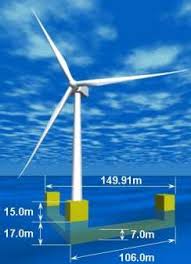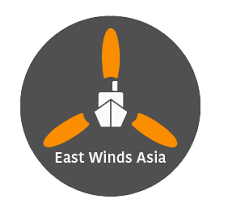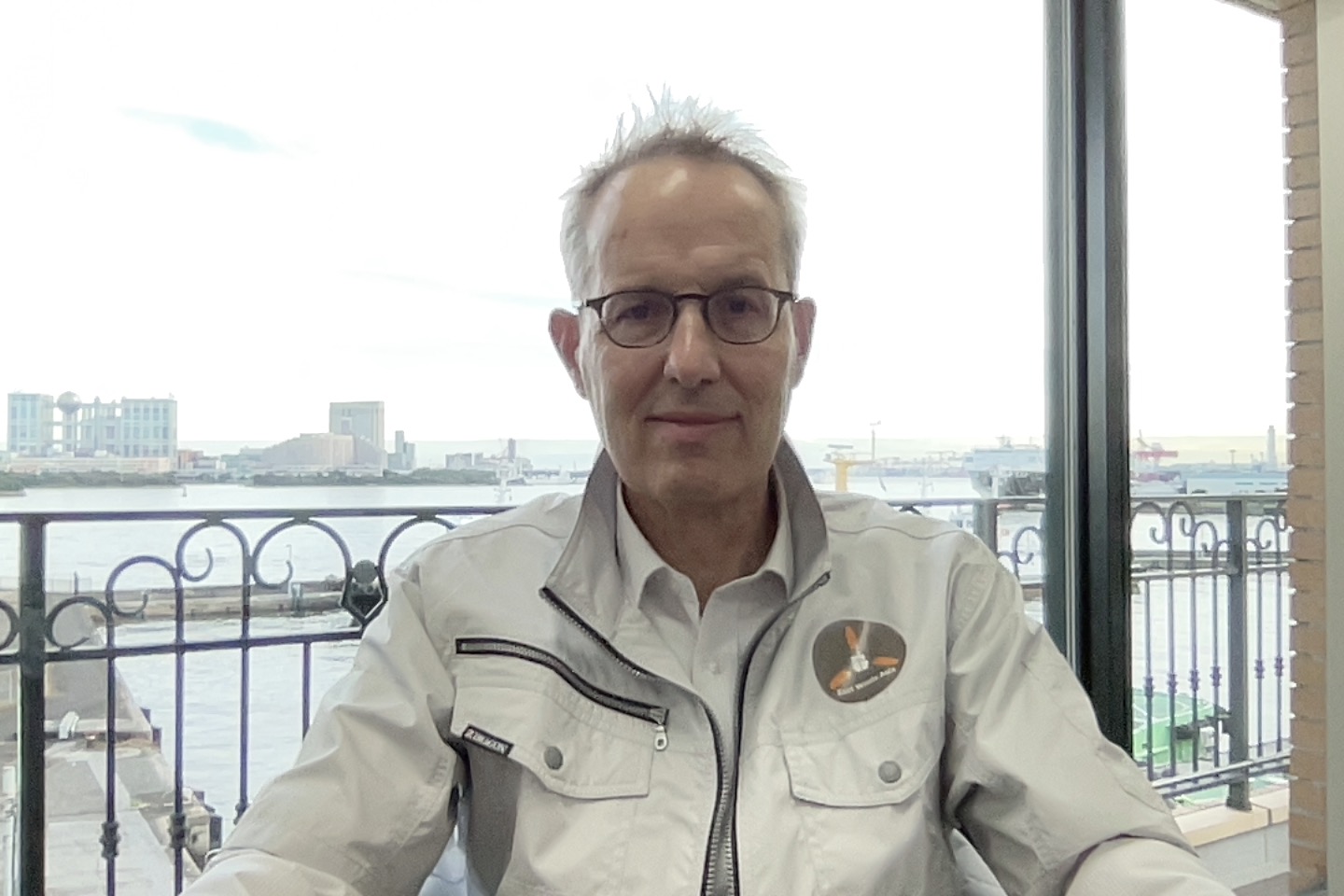The Japanese government is actively promoting offshore wind power projects. However, floating offshore wind power in deep waters, where depths exceed 60 meters from the sea surface to the seabed, still faces challenges for commercial operation. Justus Schoemaker, President of EWindsA (headquartered in Minato Ward, Tokyo), holds a degree in maritime logistics and management and has 13 years of experience working on ships. His company has been advancing cooperation between Japan and the Netherlands, a country with extensive experience in wind power projects. I spoke with President Schoemaker about the challenges and future outlook for floating offshore wind power. (Text by Hirofumi Yamamoto)
Photo courtesy= EWindsA, JMD, Ministry of Economy, Trade and Industry

1) You have extensive experience both as a seafarer and as an offshore wind power operator. Could you first tell us about your background?
I started my career as a seafarer, working on ships and gaining practical experience in the maritime industry. This early exposure gave me an understanding of the challenges involved in logistics, transportation, and day-to-day operations at sea. I later pursued an MSc in Maritime Economics and Logistics, which provided a strong foundation in the business, financial, and strategic aspects of the maritime sector.
My transition into the offshore wind industry allowed me to combine this knowledge to develop solutions for offshore projects. Recognizing the potential for collaboration between Japan and the Netherlands, I founded DUJAM Desk, followed by EWindsA, to facilitate knowledge exchange and provide specialized advisory services in commercial shipping and offshore wind. Over the years, I have advised several companies, using my international insights to support the growth of Japan’s offshore wind sector.
2) EWindsA is a business entity aimed at providing guidance and advice on offshore wind projects. What motivated you to establish EWindsA, and what are its main objectives?
EWindsA was established out of a desire to facilitate the growth of offshore wind in Japan. A key initial motivation, which remains important today, was to develop and promote transport and storage solutions using tugs and barges for the foundations and heavy components of offshore wind farms. This approach addresses logistical challenges and offers cost-effective and flexible solutions for transporting and storing large structures.
The broader motivation was to provide specialized advisory and consultancy services that support project developers, engineering companies, and other stakeholders throughout all phases of offshore wind development. Our main objectives are to mentor organizations in and entering the sector, offer strategic insights, and contribute to the localization of offshore wind expertise in Japan. We aim to support sustainable energy growth by sharing knowledge, fostering partnerships, and applying international best practices to local contexts.

3) The Japanese government is currently promoting offshore wind power projects. In general, offshore wind power installations employ various methods, such as securing monopiles to the seabed or using floating structures when water depths exceed 60 meters. Could you provide an overview of the most widely used offshore wind technologies globally, as well as other relevant methods?
Globally, the two most common offshore wind technologies are bottom-fixed and floating structures. Bottom-fixed structures, including monopiles, jackets, and gravity-based foundations, are widely used in shallow waters (up to 60 meters), where they are directly installed at the seabed. In deeper waters, floating offshore wind platforms, such as semi-submersibles, spar buoys, and tension leg platforms (TLPs), are employed. While the floating wind sector is still in its early stages, several trial projects have been successfully established, and the first commercial floating wind projects are currently under development. Each method has its benefits and challenges, depending on the water depth, seabed conditions, and distance from shore.
4) Several offshore wind power projects are build in Japan, including those off the coast of Akita and Noshiro in Akita Prefecture, Ishikari Bay in Hokkaido, and Nyuzen in Toyama Prefecture. These projects involve installing monopiles and jackets on the seabed. What challenges are currently being faced with this approach?
The main challenges for monopile and jacket installation in Japan include the harsh sea conditions, typhoons and earthquakes, as well as limited port infrastructure for handling large components. Additionally, the seabed conditions in some areas are complex, requiring detailed geotechnical surveys to ensure stability. Another significant challenge is the logistical complexity of transporting and installing these massive structures, which demands specialized transport and storage solutions, heavy-lift vessels and engineering expertise. Localizing these processes and developing adequate support infrastructure are essential for the successful deployment of monopile and jacket-based projects.

5) The Japanese government plans to expand offshore wind installations into the country’s Exclusive Economic Zone (EEZ). However, globally, there have been no commercial cases of offshore wind farms installed. What issues are associated with floating offshore wind installations ?
The deployment of floating offshore wind farms presents several challenges. While trial projects have proven the feasibility of floating installations, the transition to commercial-scale projects introduces logistical, technical and financial complexities. The design and implementation of mooring systems, anchoring solutions, and subsea cables increase costs and logistical challenges. Moreover, Japan’s strong wave and wind conditions require robust engineering solutions to ensure stability and durability. Regulatory and environmental considerations, including securing permits and managing the impact on marine ecosystems, are also critical factors that must be carefully addressed.
6) How does EWindsA plan to approach and contribute to the development of offshore wind power projects in Japan going forward?
EWindsA aims to contribute to Japan’s offshore wind development by providing tailored mentorship-based advisory services that emphasize knowledge transfer, strategic planning, and engineering support. We collaborate closely with developers, suppliers, and other stakeholders to optimize project execution and enhance local capabilities. Our approach includes mentorship-based advisory services, enabling companies to navigate the complexities of offshore wind projects and build sustainable strategies. We also focus on innovation, advocating for advanced technologies and solutions that address Japan’s specific challenges, such as floating wind development and port infrastructure optimization.
Profile
I hold a Master Mariner certification and an MSc degree in Maritime Economics and Logistics. I have a diverse background in commercial shipping and offshore wind. I began my career at sea before transitioning to onshore roles, which included working in project management and business development for international shipping and offshore wind projects. I founded DUJAM Desk and later co-founded EWindsA to facilitate cross-cultural knowledge exchange between the Netherlands and Japan, focusing on offshore wind development. I have also served as an advisor to multiple organizations, including as the representative director of Sif in Japan, which supplied foundations for the Akita Noshiro offshore wind project.
Additionally, I have organized the Holland pavilion at the Wind Expo Tokyo ten times, in collaboration with Holland Home of Wind Energy (HHWE) and the Dutch embassy in Tokyo. This initiative has played a key role in promoting Dutch expertise in offshore wind within the Japanese market and fostering strong industry connections.

〆インタビュー、イースト・ウインズ・アジア社長 ジュストゥス・シューマッハ氏、日蘭協力の架け橋に
日本政府は洋上風力発電事業を積極的に推進している。一方、海面から海底まで60メートル以上の深海での浮体式洋上風力発電は依然として商業運転に課題が残る。海運流通経営学の学位を保有し、13年間の乗船勤務の経験を持つジュストゥス・シューマッハ氏が社長を務めるイースト・ウインズ・アジア(EWindsA、本社・東京都港区)は、風力発電事業で経験豊富なオランダと日本のビジネス促進を進めてきた。シューマッハ社長に浮体式洋上風力発電の課題と今後の展望について聞いた。
(聞き手 山本裕史)
※日本語記事の続きは日本海事新聞でお読みください。
